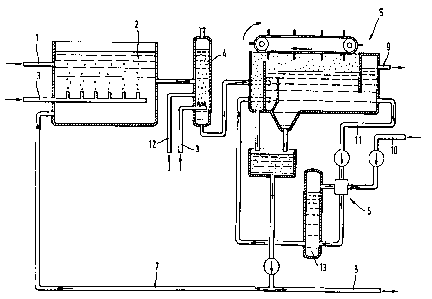Une partie des informations de ce site Web a été fournie par des sources externes. Le gouvernement du Canada n'assume aucune responsabilité concernant la précision, l'actualité ou la fiabilité des informations fournies par les sources externes. Les utilisateurs qui désirent employer cette information devraient consulter directement la source des informations. Le contenu fourni par les sources externes n'est pas assujetti aux exigences sur les langues officielles, la protection des renseignements personnels et l'accessibilité.
L'apparition de différences dans le texte et l'image des Revendications et de l'Abrégé dépend du moment auquel le document est publié. Les textes des Revendications et de l'Abrégé sont affichés :
| (12) Demande de brevet: | (11) CA 2234559 |
|---|---|
| (54) Titre français: | TRAITEMENT BIOLOGIQUE DES EAUX USEES CONTENANT DES CONCENTRATIONS ELEVEES EN BOUES |
| (54) Titre anglais: | BIOLOGICAL WASTE WATER TREATMENT AT HIGH SLUDGE CONCENTRATIONS |
| Statut: | Réputée abandonnée et au-delà du délai pour le rétablissement - en attente de la réponse à l’avis de communication rejetée |
| (51) Classification internationale des brevets (CIB): |
|
|---|---|
| (72) Inventeurs : |
|
| (73) Titulaires : |
|
| (71) Demandeurs : |
|
| (74) Agent: | SMART & BIGGAR LP |
| (74) Co-agent: | |
| (45) Délivré: | |
| (86) Date de dépôt PCT: | 1996-10-04 |
| (87) Mise à la disponibilité du public: | 1997-04-17 |
| Licence disponible: | S.O. |
| Cédé au domaine public: | S.O. |
| (25) Langue des documents déposés: | Anglais |
| Traité de coopération en matière de brevets (PCT): | Oui |
|---|---|
| (86) Numéro de la demande PCT: | PCT/EP1996/004326 |
| (87) Numéro de publication internationale PCT: | WO 1997013726 |
| (85) Entrée nationale: | 1998-04-09 |
| (30) Données de priorité de la demande: | ||||||
|---|---|---|---|---|---|---|
|
L'invention concerne un procédé de traitement biologique des eaux usées, selon lequel un mélange de boues activées et d'eaux usées subit un traitement gazeux dans un étage (2) d'épuration par boues activées puis les boues activées sont séparées des eaux traitées par flottation (5). Ledit procédé est caractérisé en ce que la concentration des boues activées dans l'étage d'épuration >= 6 g/l et que la flottation est réalisée par relaxation de pression.
The invention concerns a biological sewage-treatment method in which gas is
first passed through a mixture of sludge and sewage in an activation stage (2)
and the activated sludge then separated from the treated sewage by flotation
(5). The method is characterized in that the concentration of the sludge in
the activation stage is >= 6 g/l and that flotation is achieved by pressure
release.
Note : Les revendications sont présentées dans la langue officielle dans laquelle elles ont été soumises.
Note : Les descriptions sont présentées dans la langue officielle dans laquelle elles ont été soumises.

2024-08-01 : Dans le cadre de la transition vers les Brevets de nouvelle génération (BNG), la base de données sur les brevets canadiens (BDBC) contient désormais un Historique d'événement plus détaillé, qui reproduit le Journal des événements de notre nouvelle solution interne.
Veuillez noter que les événements débutant par « Inactive : » se réfèrent à des événements qui ne sont plus utilisés dans notre nouvelle solution interne.
Pour une meilleure compréhension de l'état de la demande ou brevet qui figure sur cette page, la rubrique Mise en garde , et les descriptions de Brevet , Historique d'événement , Taxes périodiques et Historique des paiements devraient être consultées.
| Description | Date |
|---|---|
| Inactive : CIB de MCD | 2006-03-12 |
| Inactive : CIB de MCD | 2006-03-12 |
| Le délai pour l'annulation est expiré | 2002-10-04 |
| Demande non rétablie avant l'échéance | 2002-10-04 |
| Réputée abandonnée - omission de répondre à un avis sur les taxes pour le maintien en état | 2001-10-04 |
| Inactive : Abandon.-RE+surtaxe impayées-Corr envoyée | 2001-10-04 |
| Inactive : CIB attribuée | 1998-07-14 |
| Symbole de classement modifié | 1998-07-14 |
| Inactive : CIB en 1re position | 1998-07-14 |
| Inactive : Notice - Entrée phase nat. - Pas de RE | 1998-06-19 |
| Demande reçue - PCT | 1998-06-18 |
| Demande publiée (accessible au public) | 1997-04-17 |
| Date d'abandonnement | Raison | Date de rétablissement |
|---|---|---|
| 2001-10-04 |
Le dernier paiement a été reçu le 2000-09-19
Avis : Si le paiement en totalité n'a pas été reçu au plus tard à la date indiquée, une taxe supplémentaire peut être imposée, soit une des taxes suivantes :
Les taxes sur les brevets sont ajustées au 1er janvier de chaque année. Les montants ci-dessus sont les montants actuels s'ils sont reçus au plus tard le 31 décembre de l'année en cours.
Veuillez vous référer à la page web des
taxes sur les brevets
de l'OPIC pour voir tous les montants actuels des taxes.
| Type de taxes | Anniversaire | Échéance | Date payée |
|---|---|---|---|
| Taxe nationale de base - générale | 1998-04-09 | ||
| Enregistrement d'un document | 1998-06-03 | ||
| TM (demande, 2e anniv.) - générale | 02 | 1998-10-05 | 1998-09-29 |
| TM (demande, 3e anniv.) - générale | 03 | 1999-10-04 | 1999-09-14 |
| TM (demande, 4e anniv.) - générale | 04 | 2000-10-04 | 2000-09-19 |
Les titulaires actuels et antérieures au dossier sont affichés en ordre alphabétique.
| Titulaires actuels au dossier |
|---|
| HOECHST RESEARCH & TECHNOLOGY DEUTSCHLAND GMBH & CO. KG |
| Titulaires antérieures au dossier |
|---|
| FRIEDHELM ZORN |
| HANS LOHE |
| WOLFGANG HORZ |